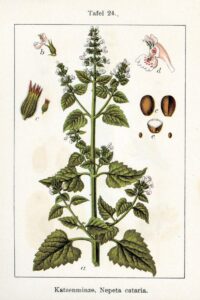Eric Yarnell, ND, RH(AHG)
Though most people are familiar with Nepeta cataria (catnip) leaf as a stimulant for cats, it is still relatively underutilized clinically. This valuable antiviral herb is safe enough for use during pregnancy and in infants and children, while simultaneously tasting great. Its calming effect and antinauseal action are added bonuses in helping sick children and adults sleep better with fewer symptoms, and thus support and promote their healing processes.
I learned the use of catnip glycerite from my mentor, Silena Heron, ND. She had been asked by a pediatric nurse practitioner in Sedona, AZ to formulate an antiviral combination that she could use to help with viral infections. This nurse practitioner was in the process of changing to a holistic practice and in particular wanted to get away from using antibiotics for patients with serous otitis media. Dr. Heron came up with a formula which worked extremely well and which this nurse practitioner still swears by to this day.
One of the secrets of the success of the formula was use of catnip glycerite. The lemony flavor of this extract, much more so than Melissa officinalis (lemonbalm) leaf, makes even Ligusticum porteri (osha) root and bitters palatable to children. Cherry fruit or Sambucus cerulea (American elder) fruit syrups and Glycyrrhiza glabra (licorice) root fluid extract are also excellent corrigents (extracts that improve flavor). All but cherry fruit syrup are also documented to have antiviral and anti-inflammatory activity.
Clinical trials are unfortunately lacking on this useful herb, and thus we are forced to rely on clinical experience and laboratory research. Several species of Nepeta have been shown to have antiviral activity in vitro (Abad, et al. 2000). Other species have been documented to be analgesic, one because of mild opioid receptor agonism by the compound nepetalactone (Aydin, et al. 1998; Aydin, et al. 1999). A methanol extract of Nepeta sibthorpii (Greek catnip), which may not resemble the more aqueous-type extract of catnip glycerite, was found to be inflammation modulating and antioxidant, with the whole extract being more active than any isolated constituents (Miceli, et al. 2005).
Not only does catnip fight viruses, it acts on other microbes as well. A diethyl ether extract of catnip, which again is likely fairly distinct chemically from catnip glycerite though it is unknown to what extent, inhibits Staphylococcus aureus enzymes and adherence in vitro (Nostro, et al. 2001). Adding a couple of drops of catnip volatile oil per dose is one way to enhance the antimicrobial activity of the glycerite. The volatile oil from various Nepeta species has shown significant antimicrobial activity in vitro (Sonboli, et al. 2004; Kalpoutzakis, et al. 2001).
Catnip glycerite finds its greatest utility in patients with upper respiratory tract infections. Generally catnip is combined with immune stimulants, diaphoretics, other antivirals, inflammation modulators, and other calming herbs. It is also useful as part of a protocol for patients with gastrointestinal tract infections. The famous Eclectic physician H. W. Felter wrote this about catnip: “A safe and valuable, though simple carminative, diaphoretic (in warm infusion), and tonic (cold infusion). A splendid quieting agent for fretful babies, and carminative and antispasmodic for abdominal pain with flatulence…the warm infusion is an admirable remedy to break up ‘common colds’ by diaphoresis…” (Felter 1922).
Typically, 15-20% of a formula needs to be catnip glycerite for its taste benefit to be significant. However, it may still have clinical activity below this level. Used as a simple, the dose would be 1-2 ml of catnip glycerite every 2-3 hours for an acute infection. As noted above, 1-2 drops (depending on body size) of catnip volatile oil can be added to each dose if a bacterial infection is suspected or known. Hot catnip tea, made from 3-5 g fresh or properly dried herb/cup (steeped 10-15 min in a covered container), drunk several times a day hot can help greatly when there is mild-to-moderate fever to enhance the healing power of this normal immune reaction. If the fever is already robust, then the glycerite or a cold infusion is preferred.
Though the glycerite and aqueous extracts have no known adverse effects, the volatile oil in excess may cause CNS depression or seizure and should be used with caution. Volatile oils should never be stored where children can get into them and should ideally be kept in childproof containers.
While catnip is not necessarily a sexy herb backed by a large European phytomedical research consortium, it is still clinically useful. Its gentleness, safety, chemical complexity, and diversity of effects confound the overly simplistic pharmacological model of medicine. It is up to naturopathic physicians and other practitioners who have directly experienced the benefits of gentle herbs like catnip to publish our cases and in-office research to jump-start larger research to document their efficacy, safety, and cost-efficiency.
 References:
References:
Abad MJ, Guerra JA, Bermejo P, Irurzun A, Carrasco. Search for antiviral activity in higher plant extracts. Phytother Res. 2000 Dec;14(8):604-7.
Aydin S, Beis R, Ozturk Y, et al. Nepetalactone: a new opioid analgesic from Nepeta caesarea Boiss. J Pharm Pharmacol. 1998 Jul;50(7):813-7.
Aydin S, Demir T, Ozturk Y, Basker KH. Analgesic activity of Nepeta italica L. Phytother Res. 1999 Feb;13(1):20-23.
Felter HW (1922) Eclectic Materia Medica, Pharmacology and Therapeutics (Sandy, OR: Eclectic Medical Publications, reprinted 1998).
Kalpoutzakis E, Aligiannis N, Mentis A, et al. Composition of the essential oil of two Nepeta species and in vitro evaluation of their activity against Helicobacter pylori. Planta Med. 2001 Dec;67(9):880-3.
Miceli N, Taviano MF, Giuffrida D, et al. Anti-inflammatory activity of extract and fractions from Nepeta sibthorpii Bentham. J Ethnopharmacol. 2005 Feb 28;97(2):261-6.
Nostro A, Cannatelli MA, Crisafi G, Alonzo V. The effect of Nepeta cataria extract on adherence and enzyme production of Staphylococcus aureus. Int J Antimicrob Agents. 2001 Dec;18(6):583-5.
Sonboli A, Salehi P, Yousefzadi M. Antimicrobial activity and chemical composition of the essential oil of Nepeta crispa Willd from Iran. Z Naturforsch [C]. 2004 Sep-Oct;59(9-10):653-6.
 Eric Yarnell, ND, RH(AHG) graduated from Bastyr University in 1996. He completed a two year residency with Silena Heron, ND and then served as chair of botanical medicine at the Southwest College of Naturopathic Medicine. He is past senior editor of the Journal of Naturopathic Medicine. Dr. Yarnell is a founding member and current president of the Botanical Medicine Academy. He is the author of numberous textbooks and articles including Naturopathic Urology and Men’s Health, Naturopathic Gastroenterology, and Clinical Botanical Medicine. His area of clinical focus is urology and men’s health. He is adjunct faculty in botanical medicine at Bastyr University and Tai Sophia Institute.
Eric Yarnell, ND, RH(AHG) graduated from Bastyr University in 1996. He completed a two year residency with Silena Heron, ND and then served as chair of botanical medicine at the Southwest College of Naturopathic Medicine. He is past senior editor of the Journal of Naturopathic Medicine. Dr. Yarnell is a founding member and current president of the Botanical Medicine Academy. He is the author of numberous textbooks and articles including Naturopathic Urology and Men’s Health, Naturopathic Gastroenterology, and Clinical Botanical Medicine. His area of clinical focus is urology and men’s health. He is adjunct faculty in botanical medicine at Bastyr University and Tai Sophia Institute.


